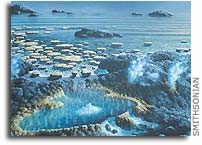Oxygen Requirements of Earth's Earliest Animals

A new study published recently in PNAS explores the relationship between the origin of animals and the oxygen content of the atmosphere.
A rise in the oxygen content of the atmosphere and oceans is one of the most popular explanations for the relatively late and abrupt appearance of animal life on Earth.
The authors challenge the widely held view that low levels of atmospheric oxygen delayed the origin of animals. Their study suggests that the last common ancestor of animals could have thrived in oxygen levels significantly lower than those we currently experience on Earth.
Evidence supporting this assertion comes from observing the survival of sponges (basal animals) under low-oxygen conditions in the laboratory. These results encourage a reconsideration of the environmental constraints on the origin of animal life.
Full paper: Oxygen requirements of the earliest animals, PNAS








